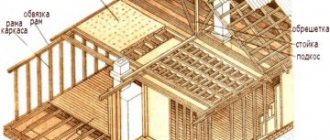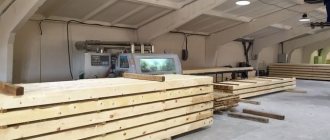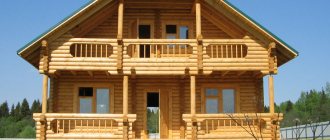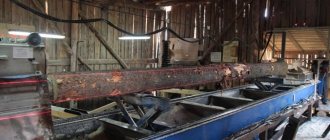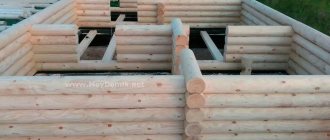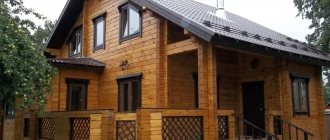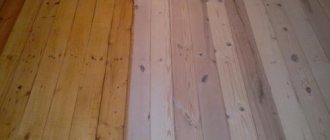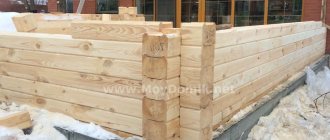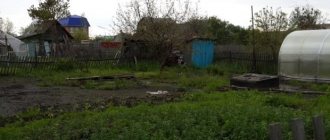Rules for laying out logs in a log house
- The layout of the log in the crown should be carried out in such a way that the thinner and denser annual rings of the tree look outward, and the wider side from the core faces inside the structure. The dense side of the log is less susceptible to shrinkage cracks, and the wide part of the sapwood creates some thermal insulation effect and is warmer.
log cut
The northern part of the log should be laid outwards. On the server side, the core of the tree trunk has denser annual rings. Due to the difference in the density of the rings, the southern side of the log retains heat better and should be facing inside the house, while the northern side is more resistant to environmental changes and is located outward. Of course, it is rare that a mass log house developer will pay attention to such a feature; this recommendation can be useful to owners who are meticulous and serious about the construction of their log house.
- A curved log with its convex side is laid either up or down. The bulge should not point inward or outward. After the final assembly of the frame, the curvature will not be noticeable.
- Between the logs, to prevent blowing and heat loss, a layer of sealant made of flax (tow), natural moss, jute and other special materials is laid. The thickness of the moss or other sealant between the logs should be approximately 2 cm. The sealant should be laid out in an even layer, extending 10 cm from the longitudinal groove and 5 cm from the bowl of the log.
You should not allow the frame to be assembled without a sealant for subsequent caulking. This way, you won’t fill up all the voids between the logs, which will be blown out and in which fungus will form and insects can infest.
- Laying the top crown
Logs with varying diameters from butt to top can be laid out in two ways:
The first method is when the butt of one log intersects with the top of a perpendicular log in the corner of the crown.
Komel - peak
The second method is when two tops and two butts of a log intersect in two opposite corners. At the same time, in each subsequent crown the intersections of the peaks and butt alternate. That is, if two vertices intersected in the corner of the lower crown, then two butt parts should intersect in the same corner of the upper crown.
The listed methods are suitable for any method of cutting the bowl.
It will be more convenient and practical for two people to lay the top log, so as not to move the unfolded compactor. It is also possible, but more difficult, to place the log in the bowl while maintaining the seal on the log. After laying, to make the log more dense, its surface is tapped with a wooden sledgehammer, popularly called a “baba”.
Fastening log logs with dowels
Every two or three crowns are fastened together with wooden dowels.
The dowel is a flat, cylindrical wooden stick, approximately 40-43 cm long, with a diameter of 2-2.5 cm. A quadrangular block with a suitable diagonal can also be used as a dowel. Any dry type of wood can be used for the dowel.
Such unification is necessary in order to:
- maintain the rigidity and strength of the log wall
- to minimize the possible formation of gaps between the crowns during shrinkage and shrinkage of the log house.
- restrain and keep logs in one plane during shrinkage
dowels for factory-produced log houses
Holes for bonding with dowels are drilled every 3 logs in height, using a drill with a diameter of 20 mm and a length of 45 mm. The distances between holes on the surface of one log should be from 1 to 1.5 meters and 20 cm from the bowl, window or doorway. Using a construction pencil or marker, mark the location of the dowel on the log. To ensure that the holes do not coincide with those below.
approximate arrangement of dowels in the crowns
If jute or tow was used as a sealant, they must be removed from the drilling areas and returned to their place after drilling. This precaution is necessary to ensure that the drill does not jam in the log due to the sealant wound around it.
If the drill jams, then when working at height, this can be traumatic and create great difficulties in removing it from the log. When using moss as a sealant, such problems do not arise.
The diameter of the dowel should be such that when driven into a log, it will hardly fit into the hole. The length of the dowel should be 5 cm less than the length of the hole itself. After driving in, the dowel should be slightly deeper into the log.
A big mistake and a complete violation of technology is the use of metal products (rebar, rods, etc.) as dowels.
In the cold season, when the dew point is inside the log and on the metal, moisture will concentrate, which will inevitably lead to wood rotting processes. In addition, when a log house shrinks, the rigidity of the metal does not allow the logs to shrink evenly in their plane, which leads to the formation of large gaps between the crowns.
The durability of a log house with metal dowels is several times less than that of a log house fastened with wooden dowels, in compliance with the technology.
How to avoid mistakes when installing a log house from rounded logs?
Many people cannot imagine what the technology of assembling a log house is, all the nuances of the process. This is important for monitoring the installation, since the consequences of poorly performed work can bring a lot of trouble, including the unsuitability of the log house for habitation.
It is important to know:
After building a log house, there are uncleaned areas of bark left on the logs, which will begin to darken over time, so the log house must be sanded.
- The permissible moisture content of the material should not exceed 20%. But there are cases when log houses are assembled from logs with high humidity, which is above 60%, which means that the forest has almost just been cut down. Such material can lead to deformation and severe cracking of the logs, as well as to the appearance of inter-crown cracks and gaps in the castle parts. Humidity leads to rotting and the formation of mold and fungal deposits. Checking the moisture content of the material is not difficult; you just need to purchase a moisture meter. Its price is not so high compared to the losses that may arise when building from low-quality material.
- An important factor is the treatment of all wooden structures with an antiseptic, bioseptic and fire retardant, since mold will subsequently be very difficult to fight, and fungus can turn the building into dust in a short time.
- Before installation, it would be useful to check the logs for straightness. The sag should not exceed 3 mm; if it exists, then it is better to discard this material, since it will be difficult to join the crowns. The first crown must be firmly connected to the base, into which steel pins are first placed, and the crowns are tightened together with dowels. If the technology is not followed, cracks will form and the frame may become loose.
- The rims must not be allowed to touch loosely over the entire plane. To correct this flaw, you will subsequently have to dismantle the entire frame; therefore, it is necessary to check the installation from the first rows.
When to cut out log windows and doors
Openings in a log house can be constructed at three stages of work:
I cut out the openings in the solid frame after shrinkage.
With this option, the most even shrinkage geometry is maintained and it becomes possible to precisely cut an opening to the dimensions of a specific door or window.
However, cutting openings in a blind log house is accompanied by a large consumption of building material. During shrinkage inside the well of a log house, due to poor ventilation, there is a risk of mold and mildew formation, and the shrinkage period of the structure also increases. Therefore, it is additionally necessary to arrange ventilation. Artificial ventilation is created either by partially cutting out small openings in the places where doors and windows are supposed to be, or the log house should stand on a ventilated base, for example, on stilts without flooring and with the roof sheathing open for ventilation.
blind log house
stuck the door in a blind log house
Arrangement of openings during the assembly of the log house
This method saves building material and money, since there is no need to pay for cubes of wood that will be cut in the openings. The ventilation of such a log house is better and shrinkage occurs faster. A temporary casing is installed in the openings for the period of shrinkage, which is a guide bar spliced with the casing board. The casing structure is inserted with a block into the groove cut out at the ends of the openings and secured. This ensures that the geometry of the openings is maintained during drying. At the same time, there is no obstacle to vertical shrinkage (up and down) and practically reduces the movement of logs in the horizon to zero.
If doors and windows are installed in the openings immediately after assembling the frame, before it shrinks, then they will definitely be damaged during shrinkage, and you will additionally have to bear the cost of new materials.
Advantages of a rounded house
To form your opinion about a log house and whether it is comfortable to live in it, you can, of course, listen to the opinions of people already living in these houses. But it is worth remembering that each person is built differently, so opinions on this matter will be subjective. Therefore, the primary task to form your own opinion is to find out all the advantages and disadvantages of this building material from experts.
The advantages of a rounded house are as follows.
Beautiful appearance . This advantage has a direct connection with the manufacturing technology of such logs. During cylindering, the bark is completely removed from the logs, and the products are made of the same correct shape.
Quick and easy assembly of a house from rounded logs. Ordinary logs are processed during construction, after which, for tight joining, each log is adjusted to the other. This takes a lot of time.
The price of rounded logs for a house is reasonable. Such a house will cost you more than construction from other materials (brick or concrete). Why are savings happening? Wooden structures are lighter than others, so a lightweight base is made for them, and interior and exterior decoration is also optional, because such a house looks beautiful without it.
Wood is a natural material, so it is an environmentally friendly material. It creates a beneficial microclimate in the house, and thanks to the smells of pine, therapeutic and preventive actions can also be carried out.
Wood has low thermal conductivity, which is why it is not hot in such a room in the summer, but warm in a wooden house in winter.
IMPORTANT! The logs fit tightly together, but to create another layer of protection from drafts and humidity, you need to use insulation. We have discussed all the main advantages, let’s move on to the disadvantages. Because every building material has them.
Trimming the ends of the log house
After assembling the log house, the ends of the logs facing outwards are usually cut with a saw to give an aesthetic appearance. It should be taken into account that the protrusion of the log must remain at least 20 cm from the corner. Using a plumb line, mark a straight vertical line along all the protrusions of the logs and cut them to size. Immediately after trimming, the ends of the logs must be soaked and coated with acrylic paint and PVA-based compounds or pure PVA glue. This measure is necessary so that the ends of the logs dry evenly with the entire body of the log and crack less.
Log characteristics
A rounded log has an even, smooth and rounded shape.
Modern logs, which have undergone initial processing in an industrial environment, make it possible to build a house very quickly. The reliability of the structure and comfort in the house is ensured by the following qualities of the log:
- the material has a very even round shape along its entire length;
- all parts are interconnected as tightly as possible;
- the tree can withstand any weather conditions;
- the log house has low thermal conductivity;
- domestically produced rounded logs comply with all European standards, their average diameter is 200-280 mm, the difference in size does not exceed 2 mm;
- The microclimate in a house made of this material is optimal for the health of the residents.
Log caulking
Caulking a log house is the process of filling the inter-crown openings with a sealant on which the logs were laid during felling. It is a long and labor-intensive process, which is mandatory, since its heat capacity and draftability depend on the quality of the caulking of a log house. Caulking of a log house is carried out in two stages: immediately after installing the log well and after its shrinkage. During further operation, non-through cracks may also arise which are recommended to be caulked.
For caulking, a metal caulk is used, a tool similar to a chisel, but with a longer pointed part. It is recommended to have several caulks in stock at once. The caulk is tapped with a wooden mallet; using a hammer for this purpose can be dangerous for the brushes and will be a more labor-intensive process. For caulking, dried and then moistened moss is used.
log caulk
Caulking of one crown is carried out from two sides at once: from the outside and from the inside. You cannot move from one crown to another without caulking it completely, as this can lead to distortions in the horizon of the crowns. Caulking begins by spreading dry caulk along the selected area between the logs. Next, the seal is tapped with caulking to secure it, folded in from below and tapped inward again. It is recommended to slightly moisten the last fibers of the sealant by spraying to give strength to the moss or tow. When you begin to feel that the seal is springing, this is a sign that the gap is completely clogged and there is no need to work harder.
The second caulking after planting is performed in the same way, but this process takes less time and takes place with less effort.
